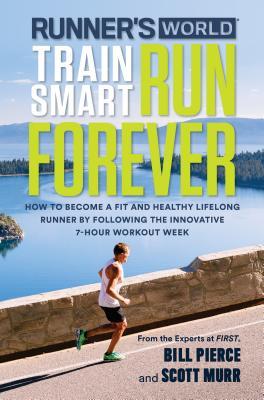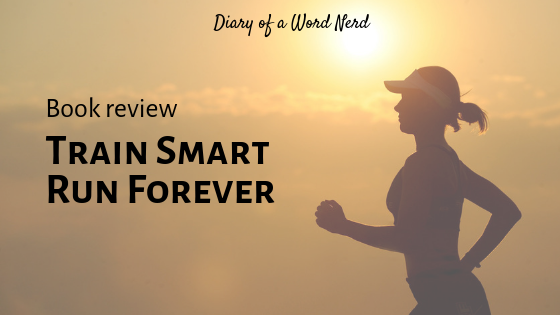I’ve been raving about Train Smart, Run Forever to friends “in real life”, so I thought I’d better share on the blog. I heard about it via the Runner’s World podcast (when it was still live), and I started applying its training concepts this January. As an aging athlete (I’m knocking on 50), I’ve struggled with nagging injuries over the past six years. But Train Smart, Run Forever has helped me prepare for a 10 mile race later this month, and the best news… no back or hip pain!
Why I picked up this book
I’ve been running since I was 11. At that early age, I learned that going for a run made my problems smaller. Not only did it help me manage my weight; it also helped me manage my mood. But I’ve always been a 30 minute, three mile kind of a runner. Especially once I had kids, I only had half an hour a day to get my fix.
Now that my kids and I are older, I want something besides the 30 minute run, but I have to choose a realistic goal. I’m not getting any speedier, so a faster 5K is not the answer. I coach high school cross country, and running with state ranked teens really shows you how fast you never were and how slow you really are. A few years ago, I spent nine months recovering from a pulled hamstring I acquired trying to beat my 13 year old daughter in 400 repeats.
So, faster times are not my goal.
However, more distance seemed achievable. Unfortunately, every time I ran more than five miles, I got back and hip pain, or more pulled muscles. I’ve turned to PTs and chiropractors for help, and I’ve also spent a lot of time walking.
Enter Train Smart, Run Forever.
What this book offers

In Train Smart, Run Forever Bill Pierce and Scott Murr share training tips from their own running experience as well as data collected from thousands of runners who have used the Furman Institute of Running and Scientific Training (FIRST). Since the early 2000s, FIRST has conducted running retreats and running clinics, and in the process, it has gathered a lot of helpful information.
The book opens with a description of FIRST and the data collected through the program. Then it explores issues relevant to the aging runner, with chapters like “Is Long Distance Running Healthy?”, “Why Do I Get Injured?” and “Don’t Forget Why You Are Doing This”. The last third of the book describes Pierce and Murr’s seven hour per week training plan, with detailed explanations of workouts and the reasoning behind them.
What I like
The Train Smart, Run Forever training program is all about balance and cross training, with an emphasis on variety, strengthening, and stretching. According to the plan, I only run three days a week. The rest of the days I cross train or strength train. The program compliments what I learned in P.T., and the variety and balance has worked well. A few weeks ago, I ran 10 miles without hurting myself, something I never thought I’d be able to do.
The Train Smart, Run Forever program isn’t time intensive. The workouts require one hour each day, with the exception of one long workout session on the weekend. I think an hour a day is a reasonable amount of time to spend on your health.
The authors of Train Smart, Run Forever spend a lot of time talking about elite runners, but the training principles apply to all levels of runners. The pacing guides are based on a wide range of 5K times, from 16 minutes to 40 minutes.
Finally, the training guide is thorough and specific. It has daily workouts with options built in for cross training, strength work, and stretching. The running workouts each have a purpose (no more “junk miles”), with Tuesdays focusing on speed intervals, Thursdays focusing on tempo runs (sustained effort over time), and weekends focusing on distance. There are even pacing guides and a perceived exertion scale to let you know how hard you should work and for how long.
What I don’t like
The first part of the book sounds like a long ad for the FIRST program. My husband actually stopped reading because of it. I just skimmed through a lot of that stuff, knowing that I would never travel to Furman to do a stress test in the FIRST lab. The training principles that come after all that are what I wanted to know about.
Recommendation
If you love to run, but you are getting older or have been sidelined by annoying injuries, you should pick up Train Smart, Run Forever. I promise, Runner’s World isn’t paying me to endorse the book. I just want more people to know about this helpful training guide.
Have you heard of this book or the FIRST program? What other exercise books can you recommend?
Thanks for getting nerdy with me!




Okay, I’m in! I’ve seen this book and have never read it.
My hips and hamstrings feel tighter by the day and after being sidelined a bit this winter I’m really trying to NOT GET HURT.
I hear you, sister!!! I think you should check it out.
I’m 52 and haven’t run for 3 weeks due to hip pain . . . very sad about it. Thanks for the recommendation!
I’m so sorry Lynne. I know how frustrating it is. I’d be happy to lend you my copy ASAP, and maybe we can compare notes on our hip ailments and find you something that will help!